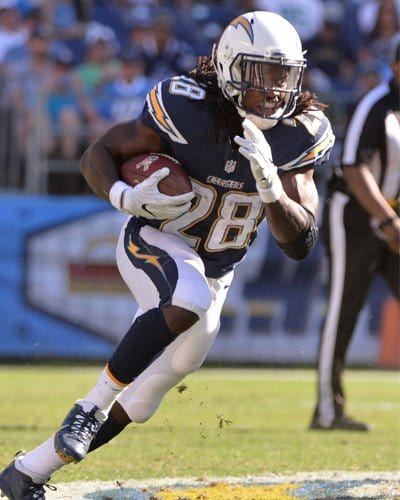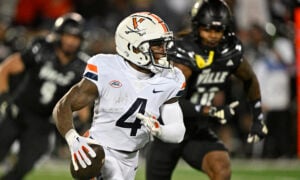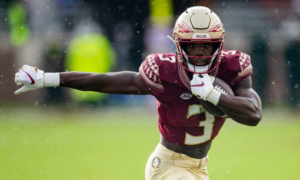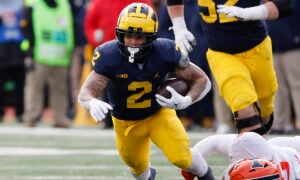Four Players to Sell for 2017
Knowing when to sell a player is a crucial aspect of being a good dynasty owner. Pull the trigger too soon and you miss out on some valuable production. Hold on to an asset for too long and his value will nosedive on your watch.
Sell a player at the right time, however, and you can flip a soon-to-be-descending asset for a valuable commodity.
So just sell players at the right time? OK. Done. Yay, this is easy.
Not quite.
The key word, obviously, is when, and it’s not always apparent when we’re in the midst of a sell-high window. Sometimes there are clues — age and unsustainable production, to name a few — but often times it’s not until a couple months after the window has passed that we realize “Shoot, I should’ve dealt Dorial Green-Beckham in August when he was a top 20 receiver!”
When dealing with player value, we need to have a baseline, so we will use the November average draft position data we have here at DLF. We will also reference a recent 12-round startup mock draft completed by DLF writers where owners could select 2017 rookie draft picks.
With each of these players below, this isn’t an attempt to say the player isn’t good or won’t play well in the future — which is very important to understand. It’s not about that.
This is all about the value of these players as assets, and whether their value may be peaking right now. It’s about managing risk and possibly looking to invest in a safer asset. It’s about trying to sell players at the right time, `which is an inexact practice, but we’ll use the information we have to at least make an educated guess.
Let’s get to it.
Quarterback
[am4show have=’g1;’ guest_error=’sub_message’ user_error=’sub_message’ ]
Marcus Mariota, QB, Tennessee Titans
Mariota is this year’s Blake Bortles — sort of. Bortles’ value shot up after a 35-touchdown season a year ago, and he was coming off the board as QB7 in startup mocks this summer. The problem was his touchdown rate was unsustainable, and while he’s still been a good fantasy producer — currently the QB7 for 2016 — Bortles may not be the starter in Jacksonville much longer if he continues throwing more than a pick per game.
Mariota isn’t headed for a Bortles-like implosion, because he’s actually good at football. But like Bortles was in 2015, Mariota is riding the wave of some unsustainable touchdown numbers. Through Week 10, Mariota has thrown 20 touchdowns passes while passing for 2,482 yards — good for a touchdown every 124.1 yards. In 2015, the NFL average for quarterbacks was a passing touchdown every 156.8 yards. That may not seem like a big difference, but it is.
Mariota has taken the touchdowns to a new level lately. Over the past five weeks, his touchdown rate is a mind-boggling 9.4 percent. For reference, Peyton Manning had an 8.3 percent touchdown rate during his incredible 55-touchdown season, and, yeah, Mariota isn’t going to sustain this.
Mariota is currently the QB4 in 2016, and as you would expect for a player in his age-23 season, Mariota’s value is shooting upwards. In our recent staff mock draft, he was the fifth signal caller taken and the 61st overall player off the board. In a similar area were LeSean McCoy, Jordy Nelson and fellow passer Russell Wilson.
In a one-quarterback league, I’d much rather have Nelson and McCoy, two excellent performers at positions where you need to start multiple players. If it’s a two-quarterback league, then Mariota’s even more valuable — probably a top 15 overall player — and would be tougher to part with. However, you may be able to swap him for an elite receiver or a lesser quarterback plus a solid wideout.
Again, like we covered in the intro, Mariota is a very good player and appears set for a good run of success, but unless he can sustain his gaudy touchdown luck, he’s likely going to put up worse numbers in 2017. If his numbers dip, his value will likely follow, even if it’s unlikely to see a significant downswing. There is safety in a good young quarterback, but in one-quarterback leagues, quarterback is the most easily replaceable position on your roster and you may be able to turn him into a good player at a more valuable position.
Running Back
Melvin Gordon, RB, San Diego
Every player who is playing really well is a possible sell-high candidate, but that’s especially true for running backs, since they typically suffer injuries more often than other positions. Opportunity is king at running back — it’s why Rob Kelley is starting for a lot of teams right now — and Gordon is getting a ton of it. If opportunity is king, then touchdowns are queen, and Gordon is living in the end zone.
He’s been a fantasy star, there’s no doubt about it, but the opportunity and touchdowns — what’s fueling his fantasy success — probably won’t work in his favor in quite this way in following seasons.
Let’s start with opportunity. Gordon has dominated the snaps in the San Diego Chargers’ backfield, playing 78.6 percent of the snaps, which is third among all running backs. He wouldn’t be getting this kind of run if Danny Woodhead were healthy. In fact, in Week 1, Woodhead’s only full game of the season, Woodhead out-touched Gordon (21 to 15). Woodhead outplayed him, too, totaling 121 yards, including 89 rushing, to Gordon’s 57 yards, and it was a game where San Diego had a positive game script for a majority of the contest, which ostensibly favors Gordon.
But with Woodhead out of the picture, Gordon has taken over. He’s carried the ball a whopping 217 times while no other Charger has more than 19 carries. The backfield is all his.
Secondly, Gordon’s touchdown numbers are nuts. After not scoring a touchdown as a rookie, Gordon has nine rushing scores and two receiving touchdowns through 10 games. He was due for positive touchdown regression coming into the year (after not scoring as a rookie), but he regressed to the mean and then kept on going. In 2015, a running back scored a rushing touchdown once every 159.8 rushing yards. Gordon has scored a rushing touchdown once every 93.1 rushing yards. That screams regression, and it’s very unlikely he keeps up this scoring pace the rest of 2016 — nonetheless 2017 and beyond.
Look, I’m not going to get into the yards per carry argument about Gordon — he’s still at a less-than-ideal 3.9 yards per run — because I think he’s a good player, and the Bolts’ offensive line isn’t great. At the end of the day, we can live with inefficiency if the player gets volume. Just about all of a running back’s output depends on snaps, touches and touchdowns, and Gordon is crushing it in all three categories. With that said, he’s probably not going to see the kind of volume next year, assuming Woodhead returns to the fold, and he’s due for some negative touchdown regression, as well. He makes for a better off-season sell, since he’ll likely keep getting volume for the remainder of 2016, but the sticker price on him may never be higher.
Gordon was the seventh back off the board in our November staff mocks, and he was the 29th overall player taken. Even if Gordon’s future outlook looked rosier, the inherent pitfalls of playing running back make him a risky asset. Going in the same area as him were wideouts DeMaryius Thomas, Sterling Shepard, Randall Cobb and Kelvin Benjamin — all of whom are much safer investments by virtue of the position they play. As far as rookie picks go, per our mock draft, Gordon’s value is right around the 1.03 or 1.04 pick, so there are a lot of ways to go if you’re a Gordon owner and you’re willing to put him on the block.
Wide Receiver
Willie Snead, WR, New Orleans Saints
I like Snead — have quite a bit of him across my leagues — but now is a good time to cash in on those shares. In his second year, Snead has been nothing but productive playing with Drew Brees. After a 69-catch, 984-yard rookie year, Snead has 46 grabs for 555 yards and four scores this season.
In a high-octane offense with a Hall of Fame passer, he’s been a valuable fantasy asset. The problem is rookie Michael Thomas jumped Snead on the New Orleans Saints’ depth chart. Heck, coming into Week 10, you could argue Thomas has passed Brandin Cooks, too, as Thomas leads the Saints in yards and targets.
Brees spreads it around as well as anyone, but he’ll also be going into his age-38 season in 2017. He hasn’t shown many signs of old age yet, putting together another superb campaign, but logic tells us Brees’ play is going to taper off at some point. When it does, I’m not sure he’ll be able to support three wideouts, and Snead would likely be the one to see a diminished role. Admittedly, I’m speculating a bit here, but it’s hard to see Thomas or Cooks falling behind Snead in terms of volume.
Snead was the 56th player off the board in our November mocks, so he certainly has plenty of value. Players in that range are Greg Olsen, Doug Martin, Davante Adams and Josh Doctson. Depending on your roster needs and how you value different positions, there are some interesting players there. Doctson hasn’t done much this year, but he’s a very talented player. Adams has resurrected his career, and Olsen is as good as it gets at tight end outside of Rob Gronkowski.
Tight End
Rob Gronkowski, TE, New England Patriots
I’ve never been someone who invested significantly at the tight end position. Like quarterback, most leagues only require you to start one, making the position easier to replace than running back and wideout (since there are usually more serviceable options on the waiver wire). So maybe it’s easier for me to say this than it would be if I valued tight end more, but now is the time to sell Gronkowski.
Like we’ve covered with the other players, this isn’t an argument against Gronk’s talent or ability; he’s a freak and probably the best fantasy tight end of all time. However, he’s playing with a very good but very old quarterback, and Gronkowski’s wrecking-ball style lends itself to injuries. Gronk hasn’t played 16 games since 2011, although he has played 15 games in each of the past two years.
Much like Brees, Tom Brady hasn’t shown any signs of slowing down, but Peyton Manning was very good in 2014 before imploding in 2015. Even the all-time greats succumb to Father Time at some point, and Brady will be embarking on his age-40 season next fall. Jimmy Garoppolo looked good in limited action this year, but Gronk probably isn’t going to be the same Earth-shattering force when Brady calls it quits. Brady and Gronkowski could make more sweet music in 2017, but as soon as Brady starts showing signs of decline — whenever that occurs — Gronk’s value is going to take a hit. It would be best to move him before that happens, even though it requires some guesswork on our part.
With an ADP just outside of the first round (13th) in our November mocks, moving Gronk could net you quite a haul. If you’re looking for a one-for-one deal, the players going in his area are DeAndre Hopkins, Todd Gurley, Alshon Jeffery, Sammy Watkins and Cooks. Since I value wideouts and running backs significantly more than tight ends, I would prefer any of those players to Gronk, as great as he is. You could miss out on some good production in 2017, but you’ll also be flipping Gronk while he’s still valued as an elite asset. If you fancy yourself as a title-contending team in 2017 — one of the two or three best rosters in your league — you should probably hold on to Gronk, but if you’re not in that situation, you could improve other areas of your roster by dealing him.
Note: With the exception of Snead, all statistics in this article are from the first 10 weeks of the season due to when the article was written.
[/am4show]
- Dynasty Capsule: Indianapolis Colts - January 17, 2019
- 2018 Summer Sleeper: Los Angeles Chargers - July 31, 2018
- Four Receivers to Sell this Off-Season - April 24, 2018


































































